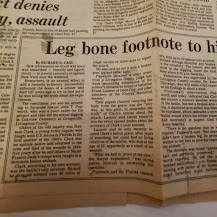Lisa and I were able to meet with Mary and Adam on Thursday to discuss the various questions we have over the Laumer collection and ask for some advice in handling the documents and organization of everything. Mary and Adam both pointed out very interesting archival concepts, such as "original order" and the copyright issues we may come across in trying to digitize photos - as well as proper care for the documents and proper care for ourselves, especially in dealing with mold or other possibly hazardous substances we may come across in the folders.
While perusing the back room of the archive on Tuesday, before meeting with Mary and Adam, I found this white binder stacked among some books on a chair. It contains Laumer's inventory of his collection, with spreadsheets documenting the document type, some with subcategories, dates, and the location of these documents (such as garage drawer 1 and so on.) Lisa and I tried to match this inventory with the file folders in the office, but it appears that when Laumer's collection was moved to the new site, it lost its original order: which Mary described as "the researcher's own order," which should be maintained for its potential usefulness to future researchers. Mary noted that this original inventory could be used in reorganizing, in the effort to restore original order, or used to present in juxtaposition with the new organizational methods, to show people what the collection originally looked like.
So, with this advice in mind - our project is veering more towards creating a strong inventory of the items in the archive, leaving the idea of reorganization and moving things around to future interns. Mary and Adam believe this inventory is the best first step.
Disappointingly, Mary and Adam encouraged us to steer clear of digitizing anything, as we may run into many copyright issues with these documents - especially because Laumer accumulated many of his primary documents from other researchers, and also because we cannot exactly verify that any of these primary pictures or documents were created by Laumer himself. Digitizing was something Lisa and I were really looking forward to doing, but with these copyright issues and the work hours that will be devoted to creating an inventory, it appears we will have to shelf this desire for another time.
The next half of our internship will be spent on site, working through folders and other documents to establish an inventory that can be used to reorganize in the future: the caveat is that we can still peruse through the interesting information that sprinkles the folders. This week I was lucky enough to explore the folder containing images, negatives. and positive slides of Ransom Clark's exhumation - a project Laumer spent years researching and pushing for. Ransom Clark was the self-proclaimed lone survivor of the Dade massacre, claiming to have sustained grievous injuries to his pelvis, shoulder, and lung, "hobbling" over 50 miles and over 4 different rivers to relate his tale to the nearest town. Clark then made a living giving lectures on his experience in the war and among the Seminole Indians.
In exhuming Clark's body, Laumer wanted to find out how true his story of sheer heroism and perseverance was - a minute detail of truth that many historians often chase. After getting a court order to exhume the body, Laumer and his associates began digging on a cold December Saturday in 1977. The autopsy showed that Clark did sustain injuries, but not as grievous and awful as he had claimed: his story of tenacity in the face of anguish may have been true, but was definitely heavily embellished.
This story has been the most interesting to read about, and I feel especially lucky to read about it from Laumer's own research and photographic recollections. I am not ashamed to say I spent way more time delving into this story and looking at the pictures than I should have - and I know Lisa was just as intrigued by the photos as I was! I hope to come across more interesting stories like this one in our endeavors to inventory everything.
Working hard at the archive :)













.jpg)





.png)

